A Race Report from the 2022 Tahoe 200
The 200-miler is the most exciting discipline in mountain running. The distance is alluring because it requires the endurance and strength demanded by an ultra-marathon and the problem-solving required on a multi-day fastpacking expedition. The discipline is a puzzle. Each race presents a challenge that, once overcome, allows some pieces to fall into place while never quite revealing the full picture. For me, tackling this puzzle amidst a 60-hour work week as a leader at a start-up and among all of life’s chaos and entropy has been a challenge and a privilege, as well as a great source of beauty.
I first ran the Tahoe 200 in 2019. The event is the only 200-mile single-loop mountain-trail race in the United States and features 40,200 feet of gain as it circles the famous lake, essentially following the Tahoe Rim Trail. I didn’t know what I was getting into but I held on for dear life, weathering unexpected snowstorms and dark hallucinations, finishing in 97:14. 2019 revealed the foundational importance of strength and endurance, not such different things after all.
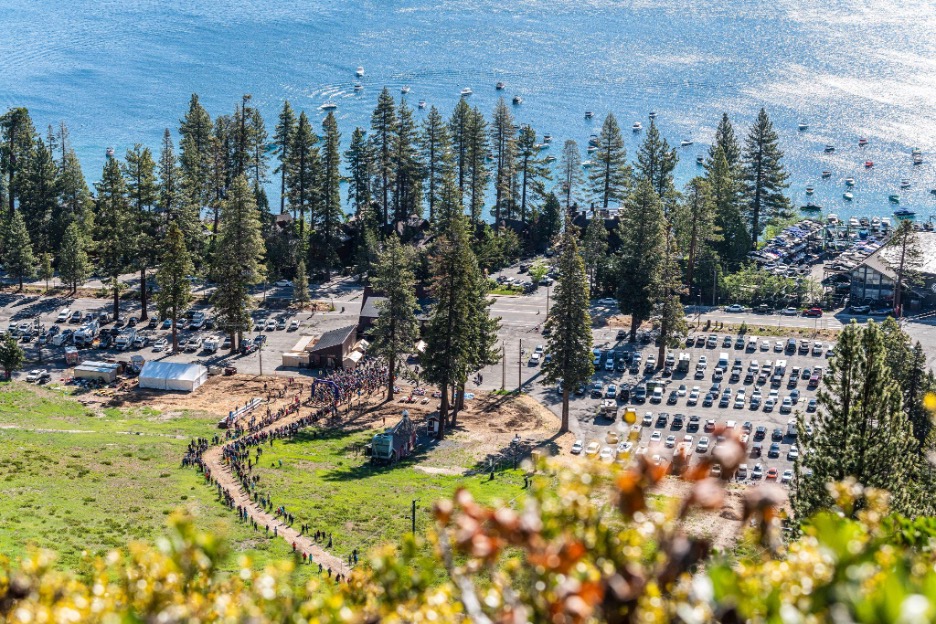
The starting line
This year I had the privilege of training with Scott Johnston. In our first conversation, I told Scott about my 2019 race and how I fell apart and barely staggered across the finish line. “I probably didn’t train enough,” I offered. Countered Scott, “I think it might be the opposite.” He then went on to introduce the core insight that completely transformed how I train. The key was targeted strength sessions that increase muscular endurance: training my brain and central nervous system to recruit muscle fibers for days on end. These sessions have kept neuromuscular fatigue at bay during long events without me having to put in endless training hours.
This approach was transformative. I’d always enjoyed 100- and 200-mile races, but they always ended painfully and slowly for me. I was resigned to the fact that I was a 50 km runner who did longer distances solely for the adventure. But this year—at the 2022 Tahoe 200—all that changed, and I was able stay mostly stay in control, and even push hard through the final section.
In June 2022, I toed the line again on a course re-routed due to the Caldor Fire (now an out-and-back from Homewood to Heavenly, rather than a circumnavigation of the lake). My goal was 84:54, and I ran the race in 91:22. While I made it halfway to my goal time, shaving a good six hours off my 2019 effort, I finished with a distinct feeling that running much faster was within grasp. I was noticeably stronger, had much more effective gear and sleep systems, and had an incredible pacer and crew. I finished the race even more enthusiastic about this punishing and highly strategic discipline.
As anyone who has run a 200-miler knows, each section has a unique feeling-tone. More broadly, my race this year had four distinct chapters.
Flow State
Start to Brockway Summit (mile 0 to 50.1)
Repeat after me: “If I get lost, get hurt, or die, it’s my own damn fault.” After 250 other runners and I chanted these iconic words at the starting line, we climbed Homewood Mountain, through and around lingering snow patches to Barker Pass at 8,500 feet. I completed this section about 2 hours faster than my 85-hour goal pace of 17.1 hours and felt incredibly strong throughout. I was aware of my tendency to go out too fast, but I kept my heart rate in zone 1 and never felt like I was pushing too hard.
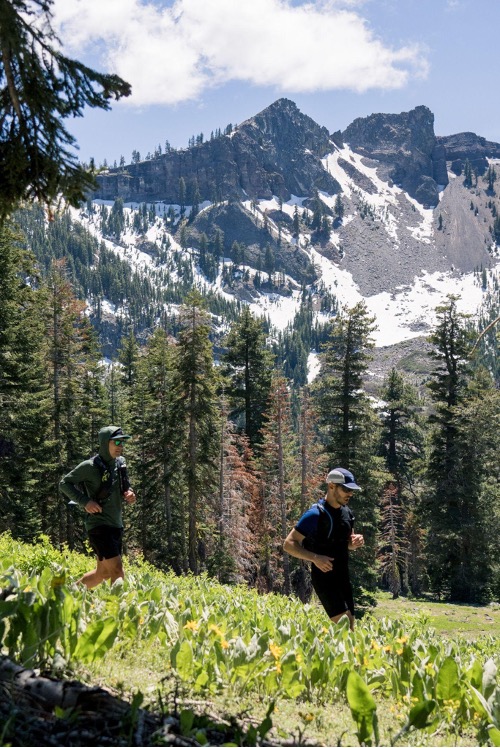
Enjoying the flow state while approaching Tahoe City. The author—Josh Goldstein—is the runner in the blue shirt.
From Barker Pass, we dropped back down to the first-aid station at Stephen Jones before running north along the lake to catch another 2,500-foot climb to Stanford Rock. This was followed by a descent into the West Shore backcountry on our way to the first crewable aid station at Tahoe City (mile 30.9) in the late afternoon.
I brought four pairs of XO 5.0 QRT socks and four pairs of Hoka Torrent 2 shoes, and the option to change into clean clothes and footwear at aid stations would prove to be one of the most effective tactics for feeling rejuvenated and avoiding blisters. After I ran through some streams, my wife, Amanda, and our friend Liz helped me change shoes and socks and grab some outerwear layers, and I got back on the rolling Tahoe Rim Trail to Brockway Summit (mile 50.1).
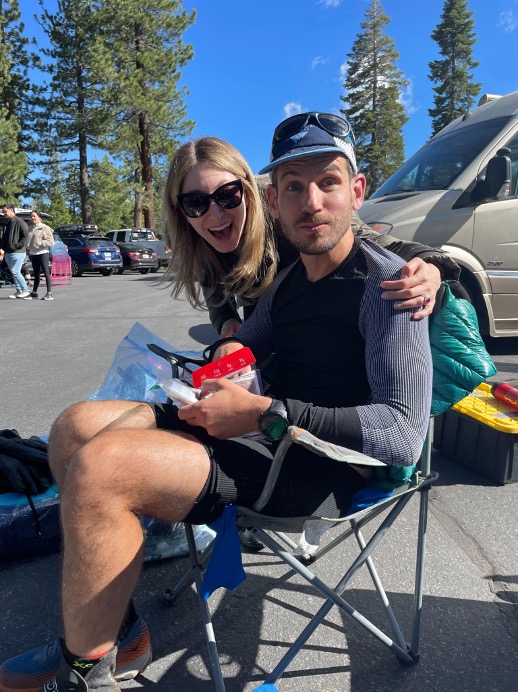
Bone Chill
Brockway Summit to Spooner Summit (mile 50.1 to 81.9)
By the time I arrived at Brockway Summit it was after midnight and the weather was starting to turn, producing hail that appeared to be falling sideways in the ferocious wind. I ate soup and a burger, and Amanda and Liz set up my luxurious accommodations in the back of the truck, where I napped for 90 minutes as planned. I drank a Red Bull and went back out on the trail with five torso layers of clothing on: XO Skin Long Sleeve 2.0 Form Fit (base layer), Patagonia Air Shred Pro (light midlayer), Salomon Essential Lightweight Hoodie (midlayer), Patagonia Alpine Down Jacket (midheavy outer layer), and a Patagonia Storm Racer Jacket (rain layer).
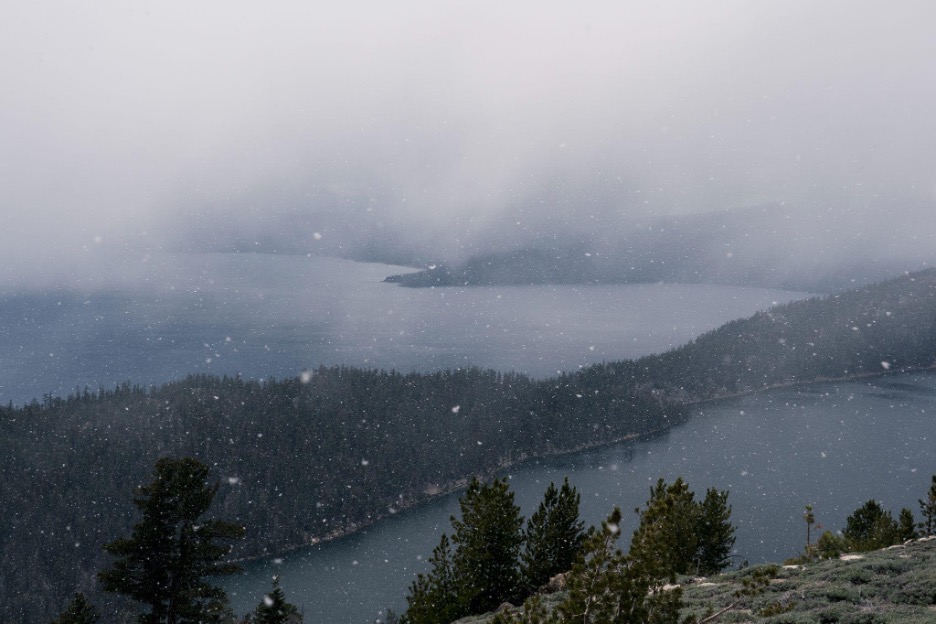
The next 13 hours were a disaster, and by far my biggest source of lost time in the race (see table below). From 3 a.m. until 5 p.m. that day, I felt a deep “Bone Chill,” and was unable to get warm no matter how many layers I had on. This was paired with a complete loss of energy and an inability to make even a few minutes of progress before having to stand still or sit down to catch my breath.
Actual Time vs Target Time – 2022 Tahoe 200
| Target (hours) | Actual (hours) | Δ Actual vs. Target (hours) | |
| Start to 50.1 | 17.1 | 15.1 | 2 |
| 50.1 to 100.2 | 20.5 | 30.8 | – 10.3 |
| 100.2 to 150.3 | 24.3 | 22 | 2.3 |
| 150.3 to 200.4 | 22.9 | 23.3 | – 0.4 |
| Total | 84.8 | 91.2 | – 6.4 |
Note: I don’t have the splits data for the first 100 miles of the race (Suunto ran out of memory and this section was overwritten) so these splits are extrapolated from a memory that my first 50 miles were ~ 2 hours ahead of pace.
I was familiar with this sensation, and I knew this would be a struggle. I have always been better with heat than cold, but I had experienced cold in dozens of races, including during a snowstorm while running the 2019 Tahoe 200, without any issue. Yet every few years I experience the dreaded Bone Chill. The most recent bout was about three years ago on a particularly cold winter day of SoCal surfing, after which I had to bury myself under blankets for an entire day to get warm. It’s as if there is a magic threshold that, once the body passes it, keeps you from allocating energy to anything other than getting warm.
In retrospect, it’s clear this was a fuel issue. With enough calories to burn, my body can prevent the Bone Chill, and just handle it as a normal bout of cold. This in turn suggests a very simple solution that I learned from a wise soul much later in the race: the Pocket Hot Dog. If you always carry an extra hot meal out of the aid station, not just snacks, you can optimize fueling.
However, at the time, I was out of luck. After a beautiful sunrise descent of the famously steep Powerline Trail and a stagger through the exclusive Incline Village community, where residents walking their dogs eyed me warily, I arrived at the Tunnel Creek aid station (mile 85) at an inopportune moment. They were apparently having some technical difficulties with hot food, and there were a dozen or so hangry runners milling about waiting for anything edible to come off the grill.
It was still cold, so I made the mistake of grabbing a few snacks and continuing on my way in my dazed and confused state, convinced I would drop out at the next aid station. The section between Tunnel Creek and Spooner Summit is the most breathtaking section of the race, with panoramic views of the lake from 9,000 feet. However, all I experienced was gray skies, howling wind, and views of ominous, waterspout-producing clouds hovering close above the water.
Reanimation
Spooner Summit to Tahoe City (mile 81.9 to 169.5)
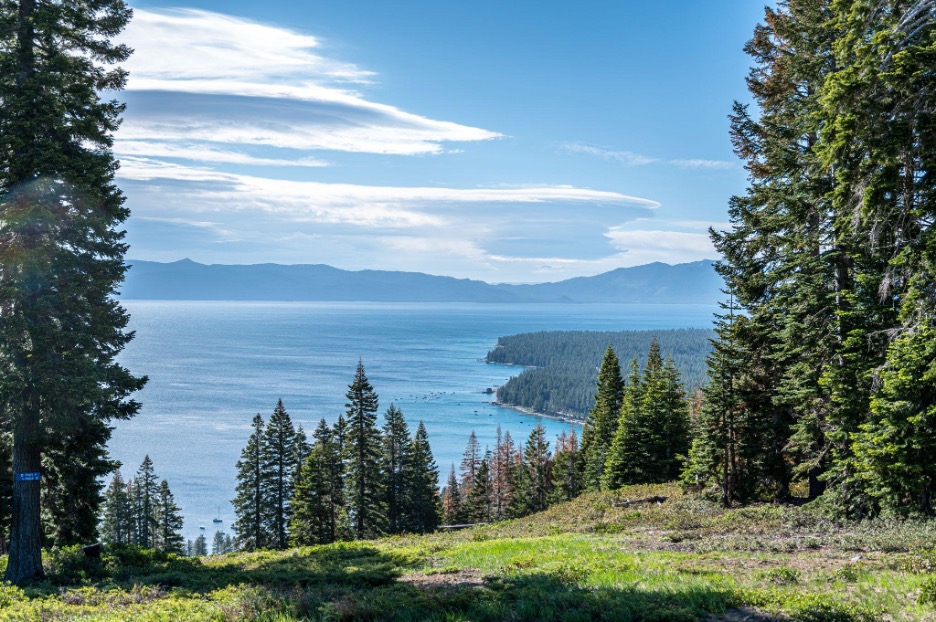
Sunshine makes all the difference.
Around eight hours after leaving the Tunnel Creek aid station I finally made it to Spooner Summit, where I promptly sat down and ate everything in sight. Now it was late afternoon with the wind dying down, and I was able to slowly rouse myself out of the abyss. With some semblance of regulated body temperature, I took two very brief trail naps and mostly regained my composure. I was able to run again, and spent the next section with a runner and his pacer, the latter of whom happened to be Mike McKnight, winner of the 2019 race. We debated whether it was harder to go up or down the Powerline Trail, and I regained the feeling that I was doing something special.
Later that evening, we saw lights—the South Tahoe casinos down in the valley, and the Stagecoach Lodge at the Heavenly aid station up in the trees. After a never-ending climb, and a slight detour off course on a Heavenly ski run, I arrived at the halfway point of the race. Here I had the incredible good fortune of having a friend who lives a few blocks from the aid station, so after I grabbed a burrito or two, Liz and Amanda whisked me off to a bed and a shower. (Note: I’ve never gone off course during a race and I’m still amazed it’s legal—but who am I to turn my back on a warm bed after 100 miles?)
I extended my planned three-hour break to four hours, changed into new clothes—switching to the Patagonia Down Sweater Hooded Jacket to increase my already-thick layering system—and headed back out around 3:30 a.m. Fortunately, I had a companion, my dear friend Alex, who had flown in from Zurich to pace me on the jaunt back to Homewood.
The first few hours were a little rough, and I was afraid the Bone Chill was returning, but once the sun came out I was able to move consistently and stay warm. Back at Spooner (mile 118.5) it was a windless, beautiful day, and I was able to leave the aid station in shorts and a T-shirt. In high spirits, we experienced Snow Valley Peak and the return trip to Tunnel Creek as they’re meant to be experienced: with bluebird skies and views of snow-capped mountains surrounding the majestic, deep-blue lake.
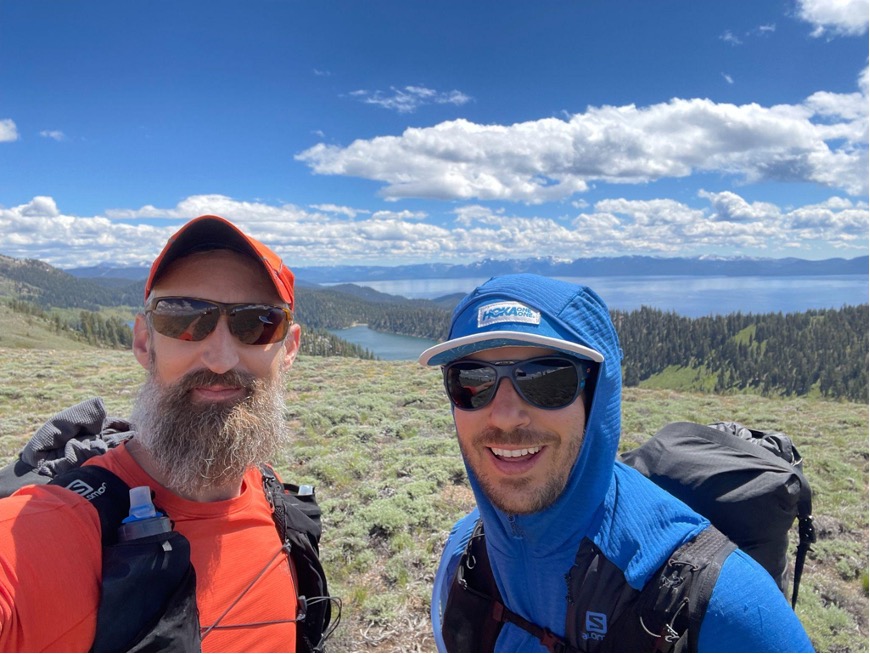
At left, Alex Bollfrass—a gentleman and a pacer—with the author, Josh Goldstein, near Snow Valley Peak on the Tahoe 200.
We made very good time to Tunnel Creek, where the aid station had fixed their technical difficulties. We heartily ate a couple burrito bowls, had some preventive Leukotape applied to our blisters, and made our way back through Incline Village. Having forgone a pacer in 2019, I can state definitively after the 2022 race that the value of having one in the back half of a 200-miler is priceless.
As we put our headlamps on at the base of Powerline, I remembered that the section ahead had been one of the darkest moments of my 2019 race. In that year, I was crawling, walking backward, and hopping, doing anything I could to get up this steep incline, with four false summits, on totally gutted legs. This year, I was completely in control. If I moved slowly, it was only to prevent injury. In some parts, I deployed the French Step, a flat-foot technique for steep snow and ice slopes that I’d learned on Mount Baker in summer 2021. Powerline was followed by many more miles of climbing, and I was able to push throughout. This is where it was most clear that, from a fitness perspective, the difference was night and day compared to 2019. The muscular-endurance work had done its job, and I got progressively faster through the back quarter of the race.
We met some characters on this section, including a software developer from San Francisco who’d lost a tooth on the first day of a 250-kilometer race in Iceland, headed to the nearest town to get a root canal, then went back and finished the six-day race. We also ran across some runners in bad shape, sitting down on the dark, tree-lined trail. We had the wherewithal to rouse them and urge them to stick with us for the remainder of the section. We spent hours discussing the ideal pizza toppings, and sent a text to our crew with the order.
We reached Brockway and greeted my third crew member, Hurricane Mike, who had arrived in the middle of the night. He brought a needed burst of energy, and Amanda brought a delicious pizza, which Alex and I devoured in the back seat. We had planned to nap in the truck, but realized our Airbnb was only a few miles away, so I was treated (an embarrassment of riches) to my second shower and clean bed.
Alex’s old foot injury was acting up at this point, so he sat the next few sections out. Changing into clean clothes and shoes (this time a half-size larger for my inflated feet), I was back on the trail at first light. Brockway to Tahoe City was entirely pleasant, with rolling hills and runnable sections. I was able to pass several runners who didn’t have much left in the tank, and a few who still had impressive pep in their step. On the last day of the race, I often develop a curiosity about the crazy humans who choose to run 200-milers, so I made it a point to chat briefly with the folks I passed. This included a gentleman who was clearly in the manic stage of his enthusiasm for ultra-running. “There was my life before Tahoe, and my life after Tahoe,” he said with wide eyes. There was also a woman from NYC who trained for Tahoe by running repeatedly over the Brooklyn Bridge. Hurricane Mike and Liz met me at Tahoe City (mile 169.5) with a fresh coffee and a cookie. I packed my Pocket Hotdog (actually a quesadilla) and hit the road.
Revelation
Tahoe City to finishing line (mile 169.5 to 200.5)
The route from Tahoe City follows a classic west-side trail known locally as Stanford Rock. It’s a long, meandering first section along Ward Creek (the only section of the race with substantial mosquitoes), followed by a challenging climb to just shy of 8,500 feet, and then a 10-mile section of switchbacks down to the lake.
In 2019, I referred to the climb after Tahoe City as the Mountain of Doom. This is where I blacked out several times, was convinced I was being stalked by a bear, and then descended into an Escher-like doom loop where I felt like I was running the same 50 feet repeatedly. I was very pleased to take on this section this year in the daylight, and I got an extra boost when, at a crossroads in the Desolation Wilderness, I came across a friend and his family who’d unexpectedly showed up to cheer me on.
The climb was slow and deliberate, and this time I did see a bear, grazing unassumingly on the hillslope, unconcerned with my presence. After putting my feet up on the summit, I started the long, 9-mile switchback descent to town and the last aid station. I found myself fading again, but this time I took a quick trail nap, put on some layers, and ate my pocket quesadilla—and I was substantially rejuvenated.

Zombie apocalypse at mile 190.
Then, inexplicably, I stumbled upon an idea that completely changed the rest of my race. The idea grew out of two related challenges. First, it was clear that I still had enough strength to push myself, but not 100 percent of the time. Second, I was dealing with the very common problem of a rapidly diminishing ability to make sense of time and distance. I would push myself for what seemed like a substantial timespan, but then look at my watch to realize it had only been 30 seconds. This, in turn, would cause frustration and lead me to default to a slower pace. At this stage in the race, I simply didn’t have enough mental energy to decide how long I could push.
For some reason, I decided to set the interval feature on my watch. At first I tried 5 minutes on and 2 minutes off, and I soon increased to 7 minutes on and 4 minutes off. During the on minutes I would push, whatever that meant for that section and that terrain. During the off minutes I would walk slowly, stretch, and even occasionally sit down and catch my breath. This was a revelation because it removed any mental energy or need for decision making, and created a game in which my attention focused on completing reps rather than on wondering how long the current section would go on. It turned what could have been a half-day death march into a swift descent to Stephen Jones (mile 190).
Alex rejoined me after a 20-minute truck nap, and I taught him my new technique as we pushed to the finish. We made amazing time on the final climb, and we even used this approach to run the last four miles, completely downhill on a ski slope to Homewood, where it had all started. I believe that using two techniques—the Pocket Hot Dog and the 7/4 Technique—beginning at the start of the race would have let me shave another 5 hours off my time. I also believe that faster (non-sleep) aid station transitions could have saved a couple more hours.
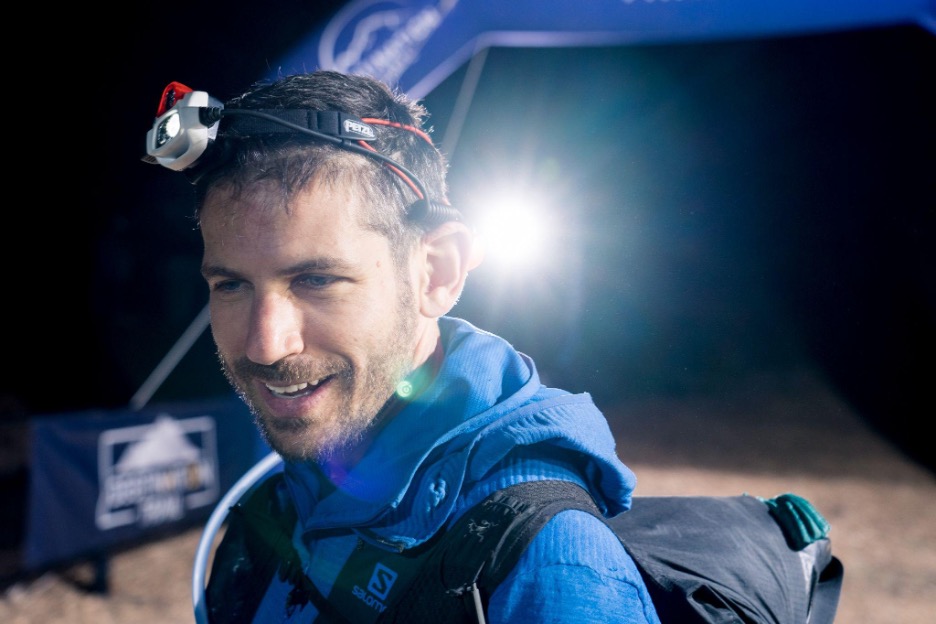
Crossing the finish line—all smiles and all done in 91:22.
On so many levels, this was one of the best races of my life. I cannot overstate the difference in fitness, mental disposition, and recovery I felt. In 2019, this race pummeled me, and I barely held on to stagger across the finish line. This year, it was a proper fight, and I was (mostly) able to keep my wits about me and be a contender.
Uphill Athlete Josh Goldstein is an ultra-runner based in Los Angeles. He mostly runs 50 kilometers (for speed) and 200-milers (for adventure). He dedicates his 2022 Tahoe 200 to his amazing wife and fearless crew captain, Amanda; his irreplaceable crew, Liz and Hurricane Mike; and his fierce pacer, Alex.
